|

Metéora
The name Metéora comes from the Greek work meteorizome, meaning "to
hang in mid-air", and the monasteries seem to do just
that, perched on a scattering of strangely shaped pinnacles
that rise out of the Peneus valley just to the north of
Kalambáka. Looming between the
Pindos range and the Thessalian plain, the rocks remain an
enigma. Some geologists say a prehistoric lake covered the
area 30 million years ago and swept away the soil and softer
stone as it forced its way to the sea. Others believe the
Peneus river slowly carved out the towering pillars, now
eroded by wind and rain, that rise to 300 m (984 ft) above
the plain.
The natural sandstone
towers of Metéora were first used as a
religious retreat when a hermit named Barnabas occupied a
cave there in 985 CE. Others joined him and also made their
homes in the caves that score many of the rocks. In 1336, they
were joined by the monk Athanásios from Mount Athos who founded the monastery of
Megálo Metéoro on one of the thousand or so pinnacles.
Twenty-three monasteries followed by the time of the Ottoman
reign of Süleyman the Magnificent (1520-66). However, due largely to
their precarious location, many had fallen into ruin by the
end of the 18th century. Until the 1920s, the only way to
get to most of the monasteries was by being hauled up in a
net drawn by rope and windlass, or by equally perilous
retractable ladders. A much quoted story
relates how an abbot, when asked how often the ropes were
changed, replied "when they break." In the 1920s
on the orders of the Bishop of Trikala, stairs were carved to
make the remaining six monasteries more accessible. Today
the ropes are used only for hauling supplies and building
materials.
Click on the thumbnails below in order to see pictures of Metéora. Use your browser's back button
to return to this page.

|
|
|
|
|
 Jeff
and four of the monasteries in Metéora as seen from the east. At his
feet is the
Monastery of Roussánou. Behind Roussánou is the Monastery of St. Nicholas Anapaphsas.
In the upper right is the
Monastery of Varlaám. The Megálo Metéoro is just slightly above Jeff's left
shoulder.
The town of Kastraki is also visible to the left. Jeff
and four of the monasteries in Metéora as seen from the east. At his
feet is the
Monastery of Roussánou. Behind Roussánou is the Monastery of St. Nicholas Anapaphsas.
In the upper right is the
Monastery of Varlaám. The Megálo Metéoro is just slightly above Jeff's left
shoulder.
The town of Kastraki is also visible to the left. |
|
 The
pinnacles of Metéora; a chaotic confusion of spikes, cone and cliffs,
beaten into bizarre and otherworldly shapes 30 million years ago. The
pinnacles of Metéora; a chaotic confusion of spikes, cone and cliffs,
beaten into bizarre and otherworldly shapes 30 million years ago. |
|
 The
soaring grey rocks located across the road from the monastery of Roussánou. The
soaring grey rocks located across the road from the monastery of Roussánou. |
|
|
|
|
|
 View of four
of the monasteries in Metéora. On the left is the
Monastery of Roussánou. Just to the right of the center is the Monastery of St. Nicholas Anapaphsas.
In the upper right is the
Monastery of Varlaám with the Megálo Metéoro just slightly above it and to the left.
The town of Kastraki is also visible. View of four
of the monasteries in Metéora. On the left is the
Monastery of Roussánou. Just to the right of the center is the Monastery of St. Nicholas Anapaphsas.
In the upper right is the
Monastery of Varlaám with the Megálo Metéoro just slightly above it and to the left.
The town of Kastraki is also visible. |
|
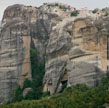 The
monasteries of Varlaám (right) & Megálo Metéoro (center) as seen
from the road. The
monasteries of Varlaám (right) & Megálo Metéoro (center) as seen
from the road. |
|
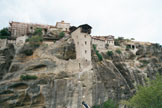 The
Megálo Metéoro, or the Great Meteoro, was built on the largest rock of
Metéora. It was also the first and, at 623 m (2,044
ft) above sea level and 415 m (1,361 ft) above the valley, highest
monastery to be founded. The first dweller on
the rock was Athanásios who in 1380 built the chapel which was restored
and added to by the monks Iosaph in 1387-88 and Simeon in 1541-42. By the
entrance is a cave in which Athanásios first lived. His body is buried in
the main church. Apart
from the main church, there are three other chapels which were built at
different times. The
Megálo Metéoro, or the Great Meteoro, was built on the largest rock of
Metéora. It was also the first and, at 623 m (2,044
ft) above sea level and 415 m (1,361 ft) above the valley, highest
monastery to be founded. The first dweller on
the rock was Athanásios who in 1380 built the chapel which was restored
and added to by the monks Iosaph in 1387-88 and Simeon in 1541-42. By the
entrance is a cave in which Athanásios first lived. His body is buried in
the main church. Apart
from the main church, there are three other chapels which were built at
different times. |
|
|
|
|
|
 The
rope net hoist of the Great Meteoro. Until 1923, access
to the monastery was by successive rope ladders and this rope net hoist. The
rope net hoist of the Great Meteoro. Until 1923, access
to the monastery was by successive rope ladders and this rope net hoist. |
|
 The
small passage and steps hewn into the rock used to climb to the Great
Meteoro today. The monastery had extensive privileges and held
jurisdiction over the others for centuries; an 18th century engraving in
its museum depicts it towering above the rest. The Monastery of Varlaám is also visible in the
background. The
small passage and steps hewn into the rock used to climb to the Great
Meteoro today. The monastery had extensive privileges and held
jurisdiction over the others for centuries; an 18th century engraving in
its museum depicts it towering above the rest. The Monastery of Varlaám is also visible in the
background. |
|
 The
Monastery of Varlaám as seen
from the Great Meteoro. I'm wearing the "highly fashionable"
attire that I was given upon entering the monastery. Women must wear
a skirt (not pants) to the knee, men must wear long pants and tuck up long hair and
both sexes must cover their shoulders. The
Monastery of Varlaám as seen
from the Great Meteoro. I'm wearing the "highly fashionable"
attire that I was given upon entering the monastery. Women must wear
a skirt (not pants) to the knee, men must wear long pants and tuck up long hair and
both sexes must cover their shoulders. |
|
|
|
|
|
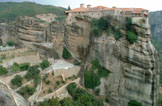 The
Monastery of Varlaám. The first dweller on the rock is thought to have
been a monk named Varlaám who in 1350 built the small chapel of the Three
Hierarchs and some cells. Almost 200 years later in 1518, the brothers
Nectarius and Theophanis, who came from a noble family in Ioánnina,
constructed a new chapel on the ruins of the former one and later those of
All Saints and John the Baptist. The
Monastery of Varlaám. The first dweller on the rock is thought to have
been a monk named Varlaám who in 1350 built the small chapel of the Three
Hierarchs and some cells. Almost 200 years later in 1518, the brothers
Nectarius and Theophanis, who came from a noble family in Ioánnina,
constructed a new chapel on the ruins of the former one and later those of
All Saints and John the Baptist. |
|
 The
Monastery of Varlaám. In 1922, 195 stairs were hewn in the rock for
safety and convenience. A rope net is also used, but only for provisions. The
Monastery of Varlaám. In 1922, 195 stairs were hewn in the rock for
safety and convenience. A rope net is also used, but only for provisions. |
|
 The
Monastery of Varlaám, atop a ravine, as seen from the road. The
Monastery of Varlaám, atop a ravine, as seen from the road. |
|
|
|
|
|
 The
Monastery of Varlaám is the second largest monastery in Metéora. The
Monastery of Varlaám is the second largest monastery in Metéora. |
|
 The
Monastery of Saint Stephen. According to
an inscription at one time on the lintel, the rock was inhabited before
1200 CE and was the hermitage of Jeremiah. The
Monastery of Saint Stephen. According to
an inscription at one time on the lintel, the rock was inhabited before
1200 CE and was the hermitage of Jeremiah. |
|
 The
Monastery of Saint Stephen contains two chapels. The old chapel of Agios
Stephanos was built in 1350. The new chapel
of Agios Haralambos was built by the monks Theophanis and Ambrosios in
1798. The monastery is linked to the opposite hill by a permanent bridge
that is eight meters long. At one time the bridge was moveable for
purposes of defense. The
Monastery of Saint Stephen contains two chapels. The old chapel of Agios
Stephanos was built in 1350. The new chapel
of Agios Haralambos was built by the monks Theophanis and Ambrosios in
1798. The monastery is linked to the opposite hill by a permanent bridge
that is eight meters long. At one time the bridge was moveable for
purposes of defense. |
|
|
|
|
|
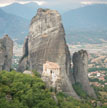 The
Monastery of Roussánou, perched precariously on the very tip of a narrow
spire of rock, is the most spectacularly located of all the monasteries.
It was probably named after the first hermit to live on
its rock. Unfortunately there are no historical records of its distant
past, but it is likely that it was founded in 1380 by the monks Nicodemus
and Benedict. In 1545, the monks Maximus and Ioasaph from Ioánnina restored and expanded it. The
Monastery of Roussánou, perched precariously on the very tip of a narrow
spire of rock, is the most spectacularly located of all the monasteries.
It was probably named after the first hermit to live on
its rock. Unfortunately there are no historical records of its distant
past, but it is likely that it was founded in 1380 by the monks Nicodemus
and Benedict. In 1545, the monks Maximus and Ioasaph from Ioánnina restored and expanded it. |
|
 The
Monastery of Roussánou (center) and the Monastery of Varlaám (left) as seen
from the south. The
Monastery of Roussánou (center) and the Monastery of Varlaám (left) as seen
from the south. |
|
 The
Monastery of Roussánou as seen from the east. Until 1897 access was by rope ladder but later
two wooden bridges were added. A permanent installation erected in 1930
now enables visitors to climb safely to the top. The
Monastery of Roussánou as seen from the east. Until 1897 access was by rope ladder but later
two wooden bridges were added. A permanent installation erected in 1930
now enables visitors to climb safely to the top. |
|
|
|
|
|
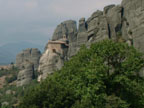 The
Monastery of St. Nicholas Anapaphsas was built in the latter part of the
15th century, probably on the ruins of an older monastery. The
Monastery of St. Nicholas Anapaphsas was built in the latter part of the
15th century, probably on the ruins of an older monastery. |
|
 The
Monastery of St. Nicholas Anapaphsas. The narrow and
limited surface of the rock obliged the monastery's proprietors to build
upward. On the first floor are the chapel and the refectory. On the second
floor are the cells. The
Monastery of St. Nicholas Anapaphsas. The narrow and
limited surface of the rock obliged the monastery's proprietors to build
upward. On the first floor are the chapel and the refectory. On the second
floor are the cells. |
|
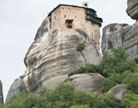 The
Monastery of St. Nicholas Anapaphsas, impossibly crammed atop a narrow
rock, as seen from the road. The
Monastery of St. Nicholas Anapaphsas, impossibly crammed atop a narrow
rock, as seen from the road. |
|
|
|
|
|
 The Monastery of
the Holy Trinity was founded between 1458 and 1476 by Dometius, who was
probably the first ascetic to take up residence on the rock. James
Bond fans will recognize this monastery from the movie, For Your Eyes
Only. The Monastery of
the Holy Trinity was founded between 1458 and 1476 by Dometius, who was
probably the first ascetic to take up residence on the rock. James
Bond fans will recognize this monastery from the movie, For Your Eyes
Only. |
|
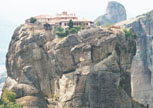 The Monastery of
the Holy Trinity. In 1888, a path was carved out of the rock. It was completed in 1925 with the
addition of 140 steps which allow visitors to reach the monastery with a minimum
of risk. The Monastery of
the Holy Trinity. In 1888, a path was carved out of the rock. It was completed in 1925 with the
addition of 140 steps which allow visitors to reach the monastery with a minimum
of risk. |
|
 The Monastery of
the Holy Trinity. In the old days, the only access was by rope ladder as in the
other monasteries. The Monastery of
the Holy Trinity. In the old days, the only access was by rope ladder as in the
other monasteries. |
|
|
|
|
|
© All pictures are Copyright 2000 Grisel Gonzalez and Jeff
Prosise
|